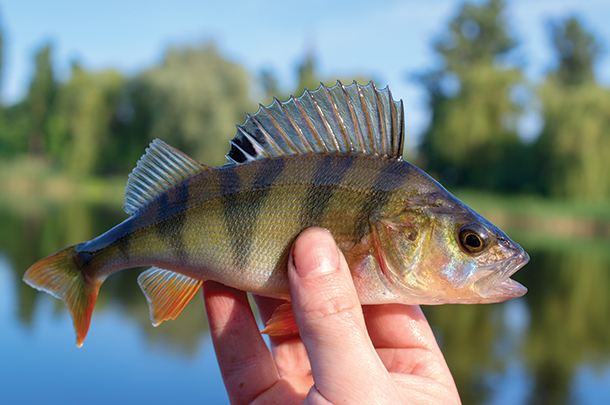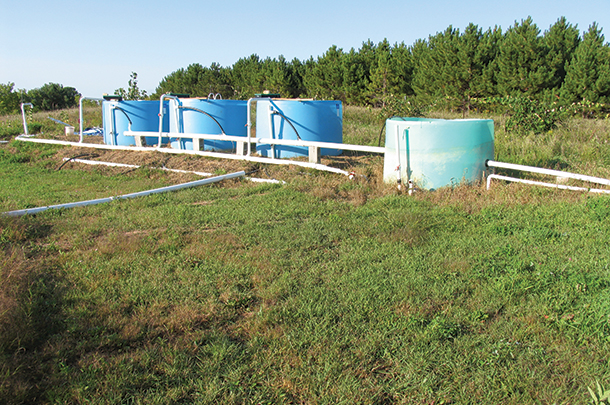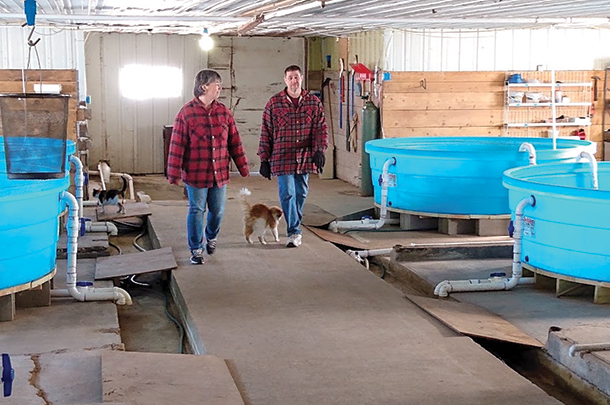Fish farmers envision the outdoor lagoon storage on these farms converted into water storage and production facilities for farm-raising fish. And the market for perch is predicted to be up for some time.
“Basically, if you look at a manure pit, it’s engineered way better than anything I could build to store water,” says Bill West, president of the Wisconsin Aquaculture Association and owner of Blue Iris Fish Farm. “The law in Wisconsin allows you to repurpose a manure lagoon if you can find a suitable repurpose objective. So I’m taking that as my opportunity to get it into aquaculture. I’m leading the charge to get these abandoned manure pits into fish production.”
Raising fish for dinner
Salmon, trout, yellow perch, bluegill, walleye, northern pike, muskellunge, bass and minnows are commonly farm-raised fish in Wisconsin, according to the Wisconsin Aquaculture Association. Yellow perch is the species of most interest to West and some other local growers. These fish are most often used for fish-and-chip dishes in restaurants.
“Restaurants have been given notice of shortages,” West says. “They are basically taking perch off the menu.”

Why are wild-caught perch on the decline? Tom Goniea, a senior fish biologist within the fisheries division of the Michigan Department of Natural Resources, says the reason is not due to the fish themselves but the food they feed on.
“There is plenty of perch hatched in the [Saginaw] Bay each year,” Goniea told Thumbwind.com, a Michigan recreational blog. “Juvenile perch are not surviving their first winter. The problem is that zebra and quaggra mussels are filtering out the zooplankton the young fish need to survive.”
Because of the decline, farm-raised perch are bringing top dollar, West says. As of 2017, there were 119 farms raising fish for sale in Wisconsin and 57 in Michigan. A majority of these farms raise trout or catfish. But up to 15 percent of them raise yellow perch and other “food fish,” according to the USDA. Demand for perch will likely encourage more producers into fish farming.
How fish are raised on former dairy farms
West says farm-raised fish wouldn’t actually be grown in former manure lagoons. Rather, the lagoons act as fresh-water storage. Water from the lagoons is then pumped into pondside tanks or tanks stored inside of former cattle barns. In fact, barns that can be heated allow farmers to grow fish year-round. However, West says a producer doesn’t have to pay to heat a facility to be able to become a fish farmer. Farmers can harvest a fish crop in just one summer season (May 1 through Sept. 30).
As with cattle, the most expensive aspect of fish-raising is the feed. For perch, the typical feed conversation rate necessary for weight gain when raising fish at optimal water temperature is 1.5 to 2 units of feed per unit of gain. Feed cost is based largely on the protein value of the feed. Perch are carnivores, and the primary ingredient in their feed is fish meal. Feed for baby fish (or frys) can cost $60 to $70 per pound. However, feed for older fish costs only $1.25 to $1.65 per pound. Perch can consume about 2% to 3% of their bodyweight per day.
Besides feed costs, West says the other costs in fish farming are power and labor. The primary electricity needs are pumping water through the tanks. Running pumps only costs $1 to $2 per day, West says. After water is pumped through the tanks, it is filtered and then returned to the lagoon to await recirculation.
“I can run everything for pondside tanks with just one person and not even full-time at that – just a few hours a day,” West says.

Before a former dairy lagoon could be used to hold water for fish farming, the pond must be emptied and the settled solids completely removed.
West says the total fish production capacity of a farm largely depends on the size of a farm’s lagoon and the time the farmer wants to spend on the operation. He has secured grant money to help educate dairy farmers about the opportunity to fish farm and to get folks signed up to participate. Those with confirmed interest this summer could be ordering fish and farming them by next spring. Between raising fish eggs, growing fingerlings (baby fish) or finishing fish for restaurants, the possibilities for new fish farmers are many.
2020 a prime time to get in the game
West says it takes about 6,000 perch to supply a small bar with enough fish for fish-and-chips meals for a year. Industry experts suggest the market demand to be 10 million pounds of perch per year. Right now, 3 million pounds are supplied. The market is “astronomical,” West says. He sells perch fillets for $15 to $20 a pound.
“There are not many fish that are going to bring that kind of money day in and day out,” West says. Those prices are similar to the same high-end prices shrimp farmers receive.

To market his fish, West direct contracts with bars or restaurants. An entire season’s harvest has been sold before it was even harvested the past few years.
“It’s hard to even keep back a few fillets to give to friends because the price I can get for them is so good.”
As he drives through the Wisconsin countryside and sees all of the “beautiful manure pits” that have been abandoned, he can’t help but think about the possibilities.
“There is a lot of opportunity here,” West says. “My objective is to have farms start with the money they have and grow with the money they can get.” ![]()
PHOTO 1: Dairy farmers exiting the industry might be able to keep farming a different species. Commercial fish farmers see potential for former dairy lagoons to be cleaned out and used to store fresh water for growing perch.
PHOTO 2: Perch. Getty Images.
PHOTO 3: An example pondside system for raising perch in tanks.
PHOTO 4: Dairy farms with enclosed facilities offer farmers who convert to raising perch the opportunity to raise fish all year in tanks kept indoors. Courtesy photos.
Contact Bill West of the Wisconsin Aquaculture Association to learn more about raising perch with fresh water stored in cleaned-out manure pits. Email Bill West or by phone at (920) 450-4641.

-
Walt Cooley
- Managing Editor
- Progressive Dairy
- Email Walt Cooley






